Synagogue

A synagogue, also spelled synagog (pronounced /ˈsɪnəɡɒɡ/ from Greek συναγωγή, synagogē, "assembly", Hebrew: בית כנסת Bet Kenesset, "house of assembly" or בית תפילה Bet Tefila, "house of prayer", שול shul, אסנוגה esnoga or קהל kahal), is a Jewish house of prayer.
Synagogues have a large hall for prayer (the main sanctuary), and may also have smaller rooms for study and sometimes a social hall and offices. Some have a separate room for Torah study, called the Beith Midrash (Sefaradi) "beis medrash (Ashkenazi)—בית מדרש ("House of Study").
Synagogues are consecrated spaces used for the purpose of prayer, Torah reading, study and assembly; however a synagogue is not necessary for worship. Halakha holds that communal Jewish worship can be carried out wherever ten Jews (a minyan) assemble. Worship can also be carried out alone or with fewer than ten people assembled together. However, Halakha considers certain prayers as communal prayers and therefore they may be recited only by a minyan. The synagogue does not replace the long-since destroyed Temple in Jerusalem.
Israelis use the Hebrew term Beyt Knesset (house of assembly). Jews of Ashkenazi descent have traditionally used the Yiddish term shul (cognate with the German Schule, "school") in everyday speech. Sephardi Jews and Romaniote Jews generally use the term kal (from the Hebrew Ḳahal, meaning "community"). Spanish Jews call the synagogue a sinagoga and Portuguese Jews call it an esnoga. Persian Jews and some Karaite Jews also use the non-Hebrew term kenesa, which is derived from Aramaic, and some Arab Jews use kenis. Reform and some Conservative Jews use the word temple. The Greek word synagogue is used in English (and German and French), to cover the preceding possibilities.[1]
Origins
Although synagogues existed a long time before the destruction of the 2nd Temple in 70 CE, communal worship in the time while the Temple still stood centered around the korbanot ("sacrificial offerings") brought by the kohanim ("priests") in the Holy Temple. The all-day Yom Kippur service, in fact, was an event in which the congregation both observed the movements of the kohen gadol ("the high priest") as he offered the day's sacrifices and prayed for his success.
During the Babylonian captivity (586–537 BCE) the Men of the Great Assembly formalized and standardized the language of the Jewish prayers. Prior to that people prayed as they saw fit, with each individual praying in his or her own way, and there were no standard prayers that were recited. Rabbi Yohanan ben Zakkai, one of the leaders at the end of the Second Temple era, promulgated the idea of creating individual houses of worship in whatever locale Jews found themselves. This contributed to the continuity of the Jewish people by maintaining a unique identity and a portable way of worship despite the destruction of the Temple, according to many historians.
Synagogues in the sense of purpose-built spaces for worship, or rooms originally constructed for some other purpose but reserved for formal, communal prayer, however, existed long before the destruction of the Second Temple.[2] The earliest archaeological evidence for the existence of very early synagogues comes from Egypt, where stone synagogue dedication inscriptions dating from the 3rd century BCE prove that synagogues existed by that date.[3] A synagogue dating from between 75 and 50 BCE has been uncovered at a Hasmonean-era winter palace near Jericho.[4][5] More than a dozen Second Temple era synagogues have been identified by archaeologists.[2]
Any Jew or group of Jews can build a synagogue. Synagogues have been constructed by ancient Jewish kings, by wealthy patrons, as part of a wide range of human institutions including secular educational institutions, governments, and hotels, by the entire community of Jews living in a particular place, or by sub-groups of Jews arrayed according to occupation, ethnicity (i.e. the Sephardic, Polish or Persian Jews of a town), style of religious observance (i.e., a Reform or an Orthodox synagogue), or by the followers of a particular rabbi.
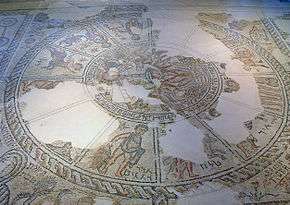 Mosaic in the Tzippori Synagogue
Mosaic in the Tzippori Synagogue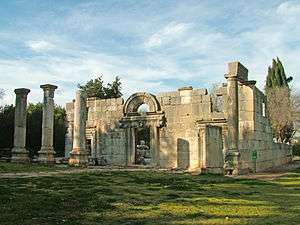 Ruins of the ancient synagogue of Kfar Bar'am
Ruins of the ancient synagogue of Kfar Bar'am
Architectural design

There is no set blueprint for synagogues and the architectural shapes and interior designs of synagogues vary greatly. In fact, the influence from other local religious buildings can often be seen in synagogue arches, domes and towers.
Historically, synagogues were built in the prevailing architectural style of their time and place. Thus, the synagogue in Kaifeng, China looked very like Chinese temples of that region and era, with its outer wall and open garden in which several buildings were arranged. The styles of the earliest synagogues resembled the temples of other sects of the eastern Roman Empire. The surviving synagogues of medieval Spain are embellished with mudéjar plasterwork. The surviving medieval synagogues in Budapest and Prague are typical Gothic structures.
The emancipation of Jews in European countries not only enabled Jews to enter fields of enterprise from which they were formerly barred, but gave them the right to build synagogues without needing special permissions, synagogue architecture blossomed. Large Jewish communities wished to show not only their wealth but also their newly acquired status as citizens by constructing magnificent synagogues. These were built across Europe and in the United States in all of the historicist or revival styles then in fashion. Thus there were Neoclassical, Neo-Byzantine, Romanesque Revival, Moorish Revival, Gothic Revival, and Greek Revival. There are Egyptian Revival synagogues and even one Mayan Revival synagogue. In the 19th century and early 20th century heyday of historicist architecture, however, most historicist synagogues, even the most magnificent ones, did not attempt a pure style, or even any particular style, and are best described as eclectic.
In the post-war era, synagogue architecture abandoned historicist styles for modernism.
Interior elements
All synagogues contain a bimah, a raised platform where the table of the rabbi is found.
The Torah Ark (Hebrew: Aron Kodesh—ארון קודש) (called the heikhal—היכל [temple] by Sephardim) is a cabinet in which the Torah scrolls are kept.
The ark in a synagogue is almost always positioned in such a way such that those who face it are facing towards Jerusalem. Thus, sanctuary seating plans in the Western world generally face east, while those east of Israel face west. Sanctuaries in Israel face towards Jerusalem. Occasionally synagogues face other directions for structural reasons; in such cases, some individuals might turn to face Jerusalem when standing for prayers, but the congregation as a whole does not.
The Ark is reminiscent of the Ark of the Covenant which held the tablets inscribed with the Ten Commandments. This is the holiest spot in a synagogue, equivalent to the Holy of Holies. The Ark is often closed with an ornate curtain, the parochet פרוכת, which hangs outside or inside the ark doors.
A large, raised, reader's platform called the bimah (בימה) by Ashkenazim and tebah by Sephardim, where the Torah scroll is placed to be read is a feature of all synagogues. In Sephardi synagogues it is also used as the prayer leader's reading desk.
Other traditional features include a continually lit lamp or lantern, usually electric in contemporary synagogues, called the ner tamid (נר תמיד), the "Eternal Light", used as a reminder of the western lamp of the menorah of the Temple in Jerusalem, which remained miraculously lit perpetually. Many have an elaborate chair named for the prophet Elijah which is only sat upon during the ceremony of Brit milah. Many synagogues have a large seven-branched candelabrum commemorating the full Menorah. Most contemporary synagogues also feature a lectern for the rabbi.
A synagogue may be decorated with artwork, but in the Rabbinic and Orthodox tradition, three-dimensional sculptures and depictions of the human body are not allowed as these are considered akin to idolatry.
Until the 19th century, in an Ashkenazi synagogue, all seats most often faced the Torah Ark. In a Sephardi synagogue, seats were usually arranged around the perimeter of the sanctuary, but when the worshipers stood up to pray, everyone faced the Ark. In Ashkenazi synagogues, the Torah was read on a reader's table located in the center of the room, while the leader of the prayer service, the hazzan, stood at his own lectern or table, facing the Ark. In Sephardic synagogues, the table for reading the Torah was commonly placed at the opposite side of the room from the Torah Ark, leaving the center of the floor empty for the use of a ceremonial procession carrying the Torah between the Ark and the reading table.
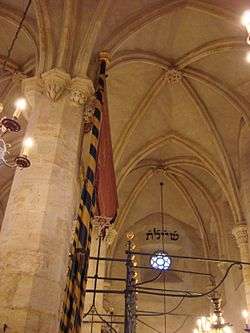 Gothic interior of the 13th-century Old New Synagogue of Prague
Gothic interior of the 13th-century Old New Synagogue of Prague- Bimah at the Bialystoker Synagogue with Torah Ark in background.
- Interior of the Portuguese Synagogue (Amsterdam) showing Tebah in the foreground, and Torah Ark in the background.
 Bimah of the Łańcut Synagogue
Bimah of the Łańcut Synagogue
Denominational differences
Orthodox synagogues feature a partition (mechitzah) dividing the men's and women's seating areas, or a separate women's section located on a balcony.
The German Reform movement which arose in the early 19th century made many changes to the traditional look of the synagogue, keeping with its desire to simultaneously stay Jewish yet be accepted by the host culture.
The first Reform synagogue, which opened in Hamburg in 1811, introduced changes that made the synagogue look more like a church. These included: the installation of an organ to accompany the prayers (even on Shabbat, when musical instruments are proscribed by halakha), a choir to accompany the hazzan, and vestments for the synagogue rabbi to wear.[6]
In following decades, the central reader's table, the Bimah, was moved to the front of the Reform sanctuary—previously unheard-of in Orthodox synagogues. The rabbi now delivered his sermon from the front, much as the Christian ministers delivered their sermons in a church. The synagogue was renamed a "temple", to emphasize that the movement no longer looked forward to the rebuilding of the Temple in Jerusalem.
Synagogue as community centre
Synagogues often take on a broader role in modern Jewish communities and may include additional facilities such as a catering hall, kosher kitchen, religious school, library, day care center and a smaller chapel for daily services.
Synagogue offshoots
Since Orthodox Jews prefer to collect a minyan (a quorum of ten) rather than pray alone, they commonly assemble at pre-arranged times in offices, living rooms, or other spaces when these are more convenient than formal synagogue buildings. A room or building that is used this way can become a dedicated small synagogue or prayer room. Among Ashkenazi Jews they are traditionally called shtiebel (שטיבל, pl. shtiebelekh or shtiebels, Yiddish for "little house"), and are found in Orthodox communities worldwide.
Another type of communal prayer group, favored by some contemporary Jews, is the Chavurah (חבורה, pl. chavurot, חבורות), or prayer fellowship. These groups meet at a regular place and time, usually in a private home. In antiquity, the Pharisees lived near each other in chavurot and dined together to ensure that none of the food was unfit for consumption.[7]
Great synagogues

During the 19th and early 20th century, it was fairly common for Jewish communities, particularly in Europe, to construct very large, showpiece synagogues. These edifices were intended not simply to accommodate worshipers, but to serve as emblems of Jewish participation in modern society. For this purpose, they were built to be not merely large, but architecturally impressive. Even small cities had elaborate synagogues of this type, albeit smaller than the synagogues of Vienna and New York. They are often designated as The Great Synagogue of..., or, in Russia, The Choral Synagogue. These notable synagogues include:
- The Choral Synagogue of Moscow
- The Grand Choral Synagogue of St. Petersburg
- The Kharkiv Choral Synagogue
- The Dohány Street Synagogue in Budapest, Hungary
- The Grand Synagogue of Paris
- The Great Synagogue of Brussels (also known as the Great Synagogue of Europe)
- The Great Synagogue of Florence
- The Great Synagogue of Oran
- The Great Synagogue of Plzeň
- The Great Synagogue of Rome
- The Great Synagogue of Stockholm
- The Great Synagogue of Sydney
- The Great Synagogue of Warsaw
- The Leopoldstädter Tempel of Vienna
- The New Synagogue of Berlin
- The Portuguese Synagogue of Amsterdam
- The Synagogue of Novi Sad
- The Synagogue of Sofia
- The Synagogue of Szeged[8]
- The Grand Synagogue of Edirne
- The Fabric Synagogue of Timisoara
World's largest synagogues

- The largest synagogue in the world is probably the Belz Great Synagogue, in Jerusalem, Israel, whose main Sanctuary seats up to 10,000. Construction on the edifice lasted for over 15 years.
- The Satmar synagogue in Kiryas Joel, New York, which is said to seat "several thousand", is also very large.[9]
- Congregation Yetev Lev D'Satmar (Rodney Street, Brooklyn) is also said to seat "several thousand", and very large.
- Temple Emanu-El of New York, a Reform Temple is located in New York City, with an area of 3,523 m2 (37,920 sq ft), seating 2,500. It is also the largest Reform synagogue in the world.
- The newly constructed Breslov Center at the graveside of Rabbi Nahman of Breslov in Uman, Ukraine, may be the largest synagogue by square footage in Europe. It is perhaps the largest by number of seats, with a capacity of up to 5,000.
- The Dohány Street Synagogue in Budapest, Hungary, may be the largest synagogue in Europe by square footage. It seats 3,000, and has an area of 1,200 m2 (13,000 sq ft) and height of 26 m (85 ft) (apart from the towers which are 43 m or 141 ft).
- The Synagogue of Trieste is the largest synagogue in western Europe.
- The Great Synagogue of Rome is one of the greatest in Europe.
- Congregation Yetev Lev D'Satmar (Hooper Street, Brooklyn) seats between 2,000 and 4,000 congregants.
- The Portuguese Synagogue in Amsterdam, also called "Esnoga", was built in 1675. At that time it was the largest synagogue in the world. Apart from the buildings surrounding the synagogue, it has an area of 1,008 m2 (10,850 sq ft), is 19.5 meters (64 ft) high. It was built to accommodate 1227 men and 440 women.[10]
- The main sanctuary of Adas Israel Congregation (Washington, D.C.) seats 1,500.
- Temple Emanu-El (Miami Beach, Florida) located in Miami Beach, Florida seats approximately 1,400 people.
- Szeged Synagogue is located in Szeged, Hungary, seats 1,340 and has height of 48.5 m (159 ft).
- The Sofia Synagogue is located in Sofia, Bulgaria, seating about 1,200.
- Congregation Shaare Zion, an Orthodox Sephardic synagogue located in Brooklyn, New York is the largest Syrian Jewish congregation in New York City. It is attended by over 1,000 worshipers on weekends.
- Kehilat Kol HaNeshama, a Reform synagogue located in Baka, Jerusalem, is the largest Reform (and largest non-Orthodox) Jewish synagogue in Israel.[11]
- Great Synagogue (Plzeň) in the Czech Republic is the second-largest synagogue in Europe, and the third-largest in the world.
- Beth Tzedec Congregation in Toronto, Ontario is the largest Conservative synagogue in North America.
World's oldest synagogues

- The oldest Samaritan synagogue, the Delos Synagogue dates from between 150 and 128 BCE, or earlier and is located on the island of Delos.[12]
- The Jericho Synagogue, the oldest, securely dated, mainstream Jewish synagogue in the world was built between 70 and 50 BCE at a royal winter palace near Jericho.[13]
- The oldest synagogue fragments are stone synagogue dedication inscriptions stones found in middle and lower Egypt and dating from the 3rd century BCE.[3]
- The synagogue of Dura Europos, a Seleucid city in north eastern Syria, dates from the third century CE. It is unique. The walls were painted with figural scenes from the Old Testament. The paintings included Abraham and Isaac, Moses and Aaron, Solomon, Samuel and Jacob, Elijah and Ezekiel. The synagogue chamber, with its surviving paintings, is reconstructed in the National Museum in Damascus.
- The Paradesi Synagogue is the oldest synagogue in the Commonwealth of Nations, located in Kochi, Kerala, in India. It was built in 1568 by the Malabar Yehudan people or Cochin Jewish community in the Kingdom of Cochin. Paradesi is a word used in several Indian languages, and the literal meaning of the term is "foreigners", applied to the synagogue because it was historically used by "White Jews", a mixture of Jews from Cranganore, the Middle East, and European exiles. It is also referred to as the Cochin Jewish Synagogue or the Mattancherry Synagogue. The synagogue is located in the quarter of Old Cochin known as Jew Town and is the only one of the seven synagogues in the area still in use.
- Jew's Court, Steep Hill, Lincoln, England is arguably the oldest synagogue in Europe in current use.
Oldest synagogues in the United States



- Congregation Shearith Israel, in Manhattan, founded in 1654, is the oldest congregation in the United States. Its present building dates from 1897.
- The Touro Synagogue in Newport, Rhode Island, is the oldest Jewish house of worship in North America that is still standing. It was built in 1759 for the Jeshuat Israel congregation, which was established in 1658.
Other famous synagogues
- The Rashi Shul in Worms, Germany, built in 1175 and razed on Kristallnacht in 1938, was painstakingly reconstructed using many of the original stones. It is still in use as a synagogue.
- The Synagogue of El Transito of Toledo, Spain, was built in 1356 by Samuel ha-Levi, treasurer of King Pedro I of Castile. This is one of the best examples of Mudéjar architecture in Spain. The design of the synagogue recalls the Nasrid style of architecture that was employed during the same period in the decorations of the Alhambra palace in Granada as well as the Great Mosque of Córdoba. Since 1964, this site has hosted a Sephardi museum.
- The Hurva Synagogue, located in the Jewish Quarter of the Old City of Jerusalem, was Jerusalem's main Ashkenazi synagogue from the 16th century until 1948, when it was destroyed by the Arab Legion several days after the conquest of the city. After the Six-Day War, an arch was built to mark the spot where the synagogue stood. A complete reconstruction, to plans drawn up by architect Nahum Meltzer, opened in March 2010.
- The Great Synagogue of Oran, Algeria, built in 1880, but converted into a mosque in 1975 when most Algerian Jews had left the country for France following independence.
- The Barbados Nidhe Israel Synagogue ("Bridgetown Synagogue"), located in the capital city of Bridgetown, was first built in 1654. It was destroyed in the hurricane of 1831 and reconstructed in 1833.[14]
- The Snoa in Willemstad, Curaçao, Netherlands Antilles was built by Sephardic Portuguese Jews from Amsterdam and Recife, Brazil. It is modeled after the Esnoga in Amsterdam. Congregation Mikvé Israel built this synagogue in 1692; it was reconstructed in 1732.
- The Bialystoker Synagogue on New York's Lower East Side, is located in a landmark building dating from 1826 that was originally a Methodist Episcopal Church. The building is made of quarry stone mined locally on Pitt Street, Manhattan. It is an example of Federalist architecture. The ceilings and walls are hand-painted with zodiac frescos, and the sanctuary is illuminated by 40-foot (12.19 m) stained glass windows. The bimah and floor-to-ceiling ark are handcarved.
- The Great Synagogue of Florence, Tempio Maggiore, Florence, 1874–82, is an example of the magnificent, cathedral-like synagogues built in almost every major European city in the 19th century and early 20th century.
- Boston MA's 1920 Vilna Shul is a rare surviving intact Immigrant Era synagogue.[15]
- The Congregation Or Hatzafon "Light of the North", Fairbanks, Alaska is the world's northern most Synagogue building.[16]
Image gallery
 Interior of a "caravan shul" (synagogue housed in a trailer-type facility) in Neve Yaakov, Jerusalem, Israel.
Interior of a "caravan shul" (synagogue housed in a trailer-type facility) in Neve Yaakov, Jerusalem, Israel. The Synagogue in the Gerard Doustraat in Amsterdam, Netherlands.
The Synagogue in the Gerard Doustraat in Amsterdam, Netherlands.


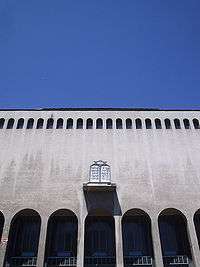





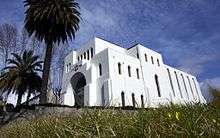
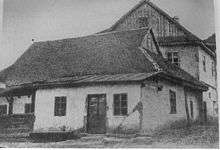 The Baal Shem Tov's shul in Medzhybizh, Ukraine (c. 1915). The original was destroyed, but has now been rebuilt.
The Baal Shem Tov's shul in Medzhybizh, Ukraine (c. 1915). The original was destroyed, but has now been rebuilt.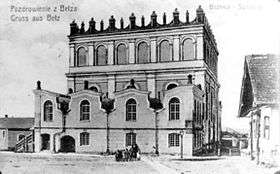
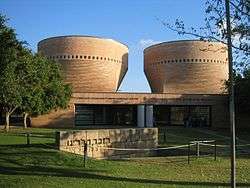

 Or Zaruaa Synagogue, Jerusalem, Israel founded in 1926 by Rabbi Amram Aburbeh in Nahlat Ahim neighbourhood, Jerusalem, Israel, exterior photo of the building declared as historic preservation cultural heritage site, on 3 Refaeli street.
Or Zaruaa Synagogue, Jerusalem, Israel founded in 1926 by Rabbi Amram Aburbeh in Nahlat Ahim neighbourhood, Jerusalem, Israel, exterior photo of the building declared as historic preservation cultural heritage site, on 3 Refaeli street. The dome of the Hurva Synagogue dominated the skyline of the Jewish Quarter of Jerusalem for more than 80 years, from 1864 when it was built until 1948 when it was bombed.
The dome of the Hurva Synagogue dominated the skyline of the Jewish Quarter of Jerusalem for more than 80 years, from 1864 when it was built until 1948 when it was bombed. The remains of the Hurva Synagogue as they appeared from 1977 to 2003. The synagogue has recently been reconstructed.
The remains of the Hurva Synagogue as they appeared from 1977 to 2003. The synagogue has recently been reconstructed.- The Ashkenazi Synagogue of Istanbul, Turkey. The synagogue was founded in the year 1900.
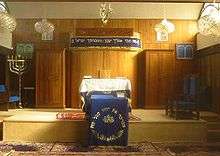 The interior of a Karaite synagogue.
The interior of a Karaite synagogue.

 The Paradesi Synagogue in Kochi, Kerala, India
The Paradesi Synagogue in Kochi, Kerala, India
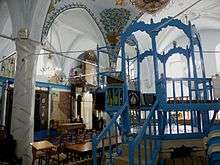 Abuhav synagogue, Israel
Abuhav synagogue, Israel Ari Ashkenazi Synagogue, Israel
Ari Ashkenazi Synagogue, Israel Santa María la Blanca, Spain
Santa María la Blanca, Spain Córdoba Synagogue, Spain
Córdoba Synagogue, Spain El Transito Synagogue, Spain
El Transito Synagogue, Spain Székesfehérvár synagogue, Hungary (c. 1930s) The synagogue no longer exists, however, the memorial plaques were moved to a building at the city's Jewish cemetery.
Székesfehérvár synagogue, Hungary (c. 1930s) The synagogue no longer exists, however, the memorial plaques were moved to a building at the city's Jewish cemetery. Sofia Synagogue, Bulgaria
Sofia Synagogue, Bulgaria- The Erfurt Synagogue is the oldest synagogue in Europe
- The Ohev Sholom Talmud Torah, the National Synagogue, is a wondrous example of mid-century modern architecture employing expressionist overtones, located in Upper 16th Street, Washington, D.C.
 Beth Yaakov Synagogue, Switzerland
Beth Yaakov Synagogue, Switzerland Sanctuary ark for Lincoln Square Synagogue, New York City (2013), by the artist David Ascalon.
Sanctuary ark for Lincoln Square Synagogue, New York City (2013), by the artist David Ascalon. Synagogue, Szombathely, Hungary
Synagogue, Szombathely, Hungary- Bevis Marks Synagogue, City of London, the oldest synagogue in the United Kingdom

See also
- Beth midrash
- Jewish services
- Shtiebel
- Siddur
- Synagogue architecture
- List of synagogues
- List of choral synagogues
References
- Levine, Lee (2005) [1999]. The Ancient Synagogue: The First Thousand Years (2nd. ed.). New Haven, Conn.: Yale University Press. ISBN 0-300-10628-9.
- Young, Penny (2014). Dura Europos: A City for Everyman. Diss, Norfolk: Twopenny Press. ISBN 9780956170347.
- ↑ Judaism 101: Synagogues, Shuls and Temples. Jewfaq.org.
- 1 2 Second Temple Synagogues
- 1 2 Pohick.org, Egypt
- ↑ Archaeology.org, Israel's Oldest Synagogue
- ↑ Jewishsf.com
- ↑ Rabbi Ken Spiro. Aish.com, "Crash Course in Jewish History Part 54 - Reform Movement"
- ↑ Alan F. Segal, Rebecca's Children: Judaism and Christianity in the Roman World, Harvard University Press, 1986, 125.
- ↑ 1340 seats, the synagogue is 48 meters long, 35 meters wide, and 48.6 meters high.
- ↑ Jewish Professionals Institute (JPI) - Holocaust Thesis Chapter 7
- ↑ Snyder, S.C. (2008). Acculturation and Particularism in the Modern City: Synagogue Building and Jewish Identity in Northern Europe. University of Michigan. University of Michigan. ISBN 9780549818977. Retrieved 2014-12-07.
- ↑ The Heart of Israel's Reform Judaism
- ↑ Delos
- ↑ Jericho
- ↑ Planetware.com
- ↑ Vilnashul.org
- ↑ "Congregation Or HaTzafon". mosquitonet.com. Retrieved 2014-12-07.
External links
| Wikimedia Commons has media related to Synagogue. |
| Wikiquote has quotations related to: Synagogue |
 "Synagogue". Encyclopædia Britannica. 26 (11th ed.). 1911.
"Synagogue". Encyclopædia Britannica. 26 (11th ed.). 1911.- Hamodia Shul Supplement
- Guide to synagogues and other Jewish heritage sites in Slovakia
- B'Nai Israel Synagogue on GuidepostUSA
- Joseph Tabory, A list of articles on Synagogues (in various languages), in Daat.col.il
- Eldridge Street Synagogue
- Webs.com
- MSN.com, Synagogue doubles as mosque during Ramadan
- Virtual Synagogues—The Texas Jewish Historical Society
